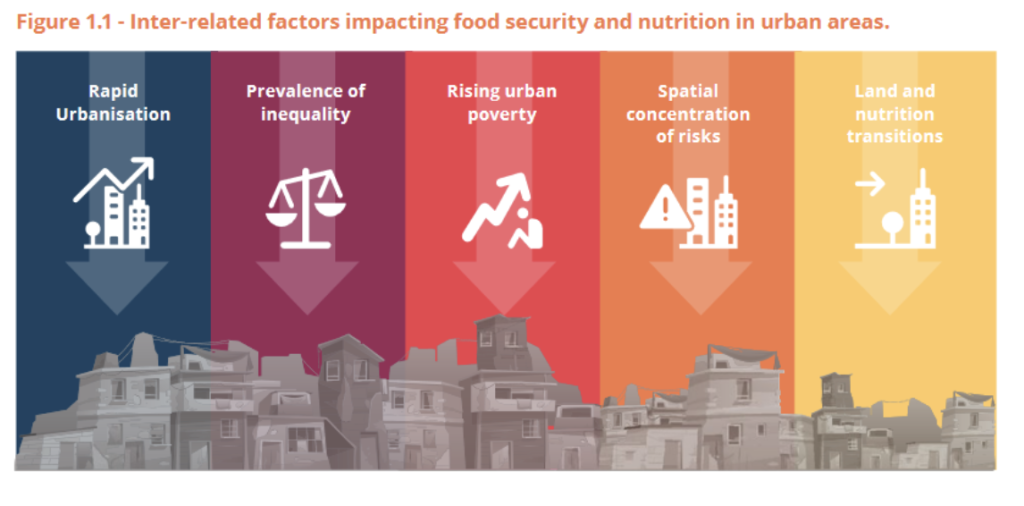Highlights:
The Urban Strategy aims to articulate WFP’s intent and priorities in urban areas, and provide a framework and strategic direction for its activities meet urgent needs and to contribute systematically to achieving zero hunger in cities.
The strategy is divided into four sections.
Chapter I sets the scene, frames the problem and explains why it is crucial to act now.
The report states that the world is increasingly urban, with 4.5 billion people or 55 percent of the global population currently living in urban areas. By 2050, this is estimated to grow by 2.3 billion, or roughly 215,000 people each day. The majority of this growth will concentrate in middle and low-income countries, with 90 percent expected to take place in Asia and Africa.
This urbanisation megatrend and several inter-related factors (Fig. 1.1) are driving up the number of people facing food insecurity and malnutrition in urban settings. These factors include a rise in urban poverty, the prevalence of urban inequality, the concentration of risks and compounded vulnerabilities in dense cities, and the land and nutrition transitions deeply transforming rural and urban relationships and, as such, the food system.

The report also analyses that urbanisation is leading to the spatial concentration of risks and compounded vulnerability (figure 1.2).

Rapid and unplanned urbanisation is resulting in land and nutrition transitions. Nutrition is shifting from traditional diets to those with less fibre and nutrients and more calories, sugar and saturated fats. This new and evolving (urban) food environment is creating a dichotomy where hunger and nutritional deficiencies coexist with obesity, sometimes within the same household.
Rapid urbanisation is transforming rural and urban relationships. The urbanisation megatrend has important repercussions for productive land, and thus for food security and nutrition. While productive land and the livelihoods of smallholder farmers and other value chain actors are threatened, the demand for food is expected to exponentially rise.
The second section of the first chapter looks at who is at risk of hunger and malnutrition in urban areas and why. It highlights the following segments of the population as particularly at risk: i) the urban poor; with ii) the differential experience of poor urban women and girls; iii) an increasing, but disenfranchised young urban population; iv) stunting in children that is increasingly urban; v) urban displaced populations as well as vi) ethnic minorities and other marginalised groups.
Chapter II provides the strategic framework set out to achieve WFP’s vision for urban areas, including its urban priorities, modes of support, and comprehensive areas of work in line with the five corporate result areas for 2022-25. Chapter III outlines the key shifts in programme policy needed to achieve the vision and other enabling factors, and Chapter IV summarises the means for implementation.
The key 5 shifts are as follows:
Shift 1: Enhancing partnerships for urban programming
Shift 2: Making data and measurement fit for urban contexts;
Shift 3: Reaching the furthest behind through people-centered targeting;
Shift 4: Leveraging the rural-urban linkages for food systems efficiency and transformation;
Shift 5: Integrating efforts with urban planning and territorial development processes.
| Year of publication | |
| Geographic coverage | Global |
| Originally published | 06 Jul 2023 |
| Related organisation(s) | WFP - World Food Programme |
| Knowledge service | Metadata | Global Food and Nutrition Security | Food security and food crises Nutrition | Food and nutrition securityAccess to food |
| Digital Europa Thesaurus (DET) | aid systemhungerurban habitatsocial protectionhumanitarian aiddisaster risk reductionVulnerable groups |
